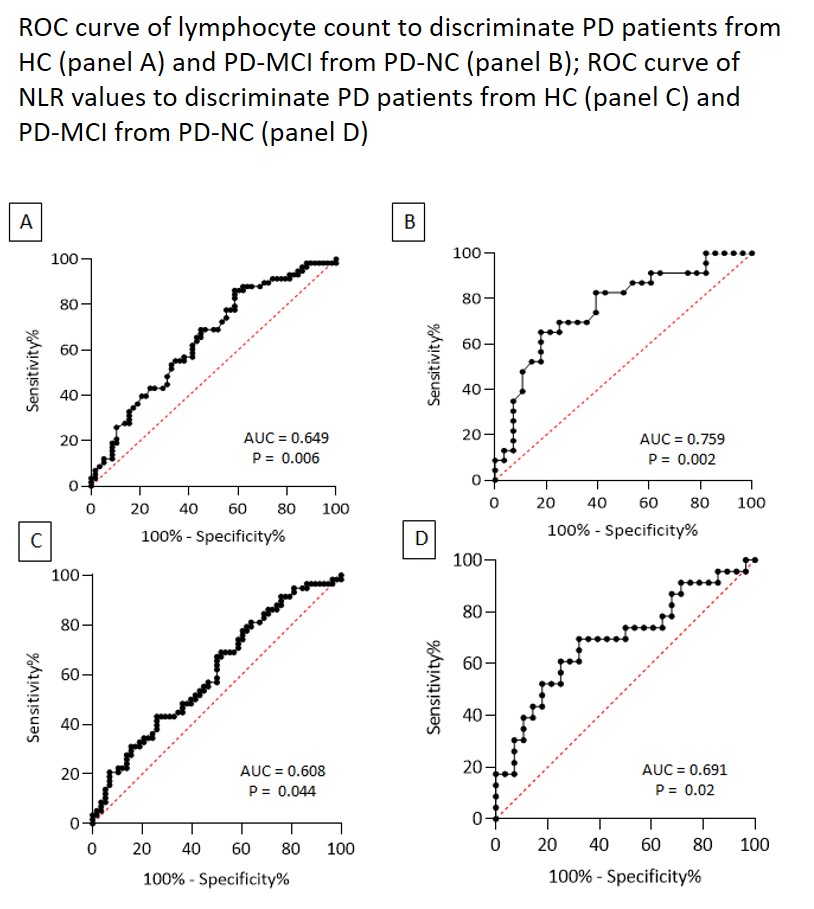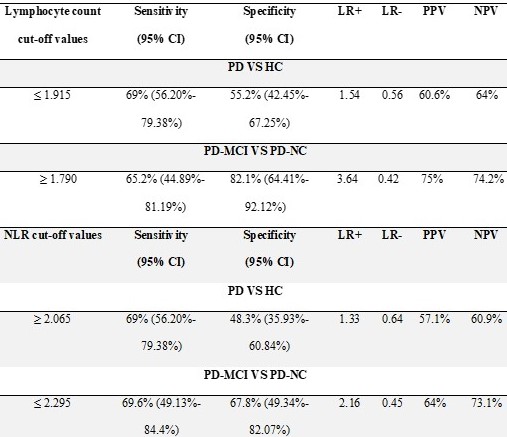Category: Parkinson's Disease: Cognitive functions
Objective: The present study aimed to elucidate whether i) lymphocyte count and neutrophil-to-lymphocyte ratio (NLR) can discriminate Parkinson’s disease (PD) patients from healthy controls (HC); ii) they could represent feasible prognostic biomarkers of mild cognitive impairment (MCI) in PD.
Background: Recent research is emphasizing the role of disrupted immune networks in the pathogenesis of PD [1]. Lymphocyte count and NLR may represent useful biomarkers of PD, but their role in mild cognitive impairment (MCI) has not been fully elucidated.
Method: Total leukocyte count with subpopulations was measured in the peripheral blood at baseline in 58 drug-naïve PD patients and 58 HC matched 1:1 for age, sex, and cardiovascular comorbidities. From this initial cohort, we then selected a subgroup of 51 patients who underwent longitudinal neuropsychological assessments through the Addenbrooke’s Cognitive Examination Revised (ACE-R) test. The last examination available was considered to analyze the relationship between ACE-R test scores and immunological measures. According to previous literature [2], a cut-off score of 89 was used to discriminate between PD-normal cognition (PD-NC) e PD with mild cognitive impairment (PD-MCI). A receiver operating characteristic curve analysis was carried out to establish the discriminatory power of lymphocyte count and NLR. The relationship between ACE-R total and subitem scores and immunological data was explored through Spearman correlation analysis.
Results: Firstly, we found that lymphocyte count was lower and NLR higher in PD than HC (p=0.006, p=0.044), with area under the curve (AUC)=0.649 and 0.608, respectively. Secondly, in PD-MCI there were significantly higher levels of circulating lymphocytes (p=0.002) and lower NLR (p=0.020) than PD with normal cognitive status (PD-NC). Correlations between lymphocyte count and ACE-R total score and memory subitem (r=-0.382, p=0.006; r=-0.362, p=0.01) as well as between NLR and ACE-R total score and memory subitem (r=0.325, p=0.02; r=0.374, p=0.007), were also found. ROC curve analysis showed that lymphocyte count and NLR displayed acceptable discrimination power of PD-MCI with AUC=0.759 and 0.691, respectively.
Conclusion: We suggest that an altered peripheral immune phenotype could foster cognitive decline development in PD, thus opening the possibility of immune-targeting strategies to tackle this disabling non-motor feature.
References: [1] Kustrimovic N, Comi C, Magistrelli L, et al (2018) Parkinson’s disease patients have a complex phenotypic and functional Th1 bias: cross-sectional studies of CD4+ Th1/Th2/T17 and Treg in drug-naïve and drug-treated patients. J Neuroinflammation 15:205. https://doi.org/10.1186/s12974-018-1248-8
[2] McColgan P, Evans JR, Breen DP, et al (2012) Addenbrooke’s Cognitive Examination-Revised for mild cognitive impairment in Parkinson’s disease. Mov Disord 27:1173–1177. https://doi.org/10.1002/mds.25084
To cite this abstract in AMA style:
E. Contaldi, L. Magistrelli, S. Gallo, C. Comi. Lymphocyte count/neutrophil-to-lymphocyte ratio and mild cognitive impairment in Parkinson’s disease [abstract]. Mov Disord. 2022; 37 (suppl 2). https://www.mdsabstracts.org/abstract/lymphocyte-count-neutrophil-to-lymphocyte-ratio-and-mild-cognitive-impairment-in-parkinsons-disease/. Accessed December 18, 2025.« Back to 2022 International Congress
MDS Abstracts - https://www.mdsabstracts.org/abstract/lymphocyte-count-neutrophil-to-lymphocyte-ratio-and-mild-cognitive-impairment-in-parkinsons-disease/


